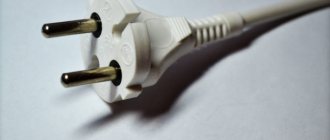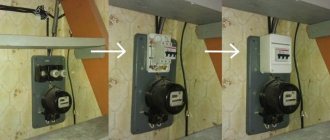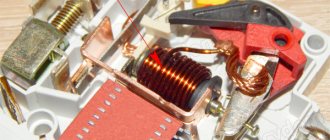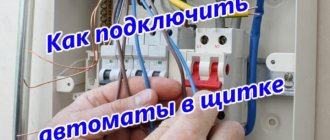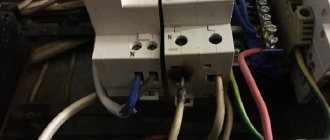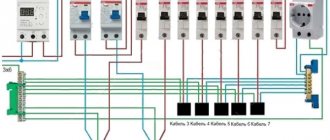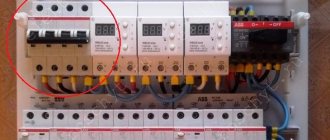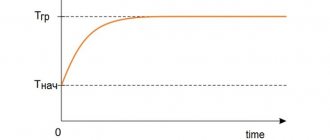If the heating of the plug of the machine is unexpectedly detected in the room, first of all, you need to disconnect all working electrical appliances from the network. Because the consequences of such long-term exposure can be very unpleasant. Heating is often associated with excess current consumed by electrical appliances. Therefore, if the plug on the meter is heating up , there may be several reasons.
The main reason for heating is the flow of large current through old or weak wiring in the room. This process can occur when connecting new powerful consumers of electrical energy, as well as when connecting a large number of receivers at the same time. The destruction of wiring insulation, the actual aging of conductors, also affects the current level in the network. In addition, one of the reasons may be a mechanical malfunction of the machine plug itself, for example, poorly drawn contacts. So, what to do if the automatic plug is heating up?
It should be said that eliminating the problem that has arisen without special education is extremely dangerous. Therefore, in most cases it is better to trust a qualified specialist. Telephone numbers of emergency and other services can be easily found on the bulletin board at the entrance, in various advertising newspapers or on the Internet.
When doing any work on the electrical network, the first thing you need to do is turn off the input circuit breaker. This measure is very important because it allows you to avoid being exposed to voltage.
Fuse selection procedure
To ensure uninterrupted and safe operation of the electrical network, fuses must be selected taking into account the expected operating conditions. To do this, the general power indicators of the operated devices are summed up.
A simple calculation example. In the house it is possible to simultaneously turn on the following electrical appliances with power indicators:
- refrigerator (450 W);
- electric stove (6000 W);
- microwave oven (2000 W);
- TV (180 W);
- washing machine (800 W);
- lighting devices (400 W).
The total value of the electric current is calculated using the formula:
A = ∑Р/U, where:
- A is the desired current value in amperes;
- ∑Р – the total power of electrical appliances, in this case equal to 450 + 6000 + 2000 + 180 + 800 + 400 = 9830 W;
- U – rated voltage value equal to 220 V.
Substituting the numbers into the formula, we get:
A = 9830/220 = 44.68 A.
Circuit breakers are manufactured with different current limit values. The closest standard model in terms of current is rated at 50 A.
Additionally, you will need to check the cross-section of the electrical wiring wires for the total power of electrical appliances in order to eliminate the risk of thermal overheating of the network. The indicator is checked against the table, depending on whether copper or aluminum wiring is used:
In the example given, the cross-section of the wires must be no less than:
- for copper – 6 mm;
- for aluminum – 10 mm.
If it turns out that the cross-section of the wire in the home network is less than specified, it is recommended to change the wiring to eliminate the risk of fire and failure.
It is recommended to purchase circuit breakers instead of outdated plugs. It is advisable to use a two-pole switch that turns off both phases simultaneously. If you install separate switches on the neutral and phase wires, when the contact at zero is disconnected, the phase will remain connected, which is associated with the risk of failure of electrical appliances.
Types of electrical plugs
The following types of fuses are produced:
- ceramic base type - an outdated model, where the safety function is performed by a fusible insert. If the load increases beyond the standard, the insert burns out and needs to be replaced. Often, consumers using such fuses, if there is no insert, install jumpers. This method of repair leads to the fact that the fuse ceases to perform its functions, which creates the danger of fire and failure of the electrical wiring;
Ceramic base type - automatic plinth – an improved model of the previous model. Allows you to turn off the network when the parameters are exceeded and then turn it on by pressing a button. Unreliable and short-lived, they quickly fail;
Base automatic - circuit breakers are modern devices that ensure network shutdown in emergency situations. Mounted on DIN rail.
Circuit breakers
The machines are characterized by a number of advantages:
- reliability and durability;
- the ability to select models with different current levels and response speeds;
- ease of use;
- quick and easy installation;
- compact size and attractive appearance.
We produce versions of circuit breakers equipped with a thermal relay that opens the electrical circuit when the temperature rises, which provides additional reliability.
If you can't fix the problem yourself
If there is no access to the electrical panel, which in principle is absolutely unacceptable either in an apartment or in a house, or there is no voltage after the meter, then one logical question arises - where to call and where to go? Naturally, only to the electricity supplier company with whom the contract for its consumption has been signed. Opening closed switchboards or meters is prohibited. If an accident occurs at night and you cannot fix it yourself, then in every area there are emergency services around the clock and the solution to the problem can be entrusted to them.
Now you know why the plugs in the apartment are knocked out and how to determine the reason for the operation. We hope the information provided was useful and interesting for you.
You probably don't know:
- Why does the circuit breaker in the panel trip?
- Reasons for tripping the RCD
- How to deal with low voltage in the network
- How to replace plugs with circuit breakers
Published: November 2, 2017 Updated: November 2, 2017
The plugs on the meter are heating up
Good day to all! I have this situation: the plugs on the meter began to heat up wildly (they were ceramic), they got very hot, one day it even got to the point of charring. Of the most “gluttonous” equipment at home, there are 2 refrigerators, a washing machine, and a water heater. The electrician looked and said the plugs were bad (the contacts were shorting ).I replaced the plugs themselves with automatic plugs, and the blocks into which they are screwed in (sorry, I don’t know what they are called correctly). Everything seemed to be fine. But this morning it started again - the smell of plastic, I see, one plug is quite strong warmed up. At this time the refrigerator and heater were working. I urgently turned off the heater - .Where is the rake? It seems like there shouldn’t be a lot of consumption, the Thermex 15 liter water heater consumes, of course, great, but not that much. And even if there was a lot of consumption, the plugs would have to work, as I understand it. Is there a problem with the contacts again? Who will say what? Thanks in advance to everyone who responded.
Check what
Everything: from the parameters of the incoming voltage to the technical condition of consumers. Don’t forget to carefully inspect the electrical panel, wires, insulation, all possible contacts and connection points. It’s a good idea to take measurements, but this will require special instruments.
The problem of overheating of the electrical plug in the panel can be resolved by a qualified electrician with the required approval group. Owners are required to follow basic safety rules and take care of the proper condition of devices and equipment.
If you want to live in conditions of electrical safety and energy comfort, check electrical installations, replace and repair if necessary. There is no other option.
This is interesting: The electric kettle does not work: how to find the breakdown and repair it
Why do traffic jams heat up in the house?
Go to the store and buy stronger plugs.
If after this the plugs still heat up, then the reason is in the connection of the wires (you need to check all the connections on the meter. Or the wiring itself is weak (it needs to be replaced). Call an electrician and he will check everything for you and tell you the reason. If necessary, he can repair everything.
Valery Nikolaevich 18 Aug 2014 13:54
Why do traffic jams heat up in the house?
One of the most common reasons why plugs on an electrical panel can heat up is the presence of defective (bad) contact in the circuit; this could be problems with the wires or with the contacts in the plug itself. It is quite possible that the cause is poor contact of the neutral wire, which your local electrician has access to.
First of all, you need to check the contact connections in the shield, then the contacts on the plug. All of these actions should be entrusted to a specialist electrician or knowledgeable person.
In some cases, the plugs may become hot due to loose screws/bolts on the shield itself. To eliminate the cause, just tighten them with a tool. In this case, the instrument must be insulated, but it is better to invite a specialist.
Another reason for the plug to heat up is that it was not completely screwed in initially. As a result, the central contact began to burn (between the petal and the tip of the plug), and then an irreversible process began to develop. Burning is followed by oxidation, and then deterioration of contact and even greater heating, all this leads to overheating of the metal of the petal. You can take it all apart, clean it, replace the contact, install a spring.
To eliminate the problem of heating plugs, it is better to contact a specialist.
Turning the electricity back on
Restoring power supply is simple; short instructions on how to turn on the plugs consist of three steps.
- Analyze the situation, identify the malfunction, the electrical panel will help with this. The triggered machine will be in the “Off” position.
- Eliminate the cause of the shutdown.
- Turn AB or plug into working position. Electricity will be restored.
The power supply of an apartment is a complex engineering system. If you have even the slightest doubt about your own abilities, then the best solution to the problem is to call an electrician to carry out restoration work. This will be more reliable and safer.
For what reason can the zero plug on the electric meter get warm?
From the exotic. Apply full-wave three-phase star rectification. Like 3 diodes per phase and a direct current three times greater than in the phases will flow across the zero. What I mean is that there may be more reasons than will be mentioned here
Other answers
Due to poor contact. Either zero or phase. Another reason could be that the plug is working at the limit of its capabilities and therefore gets hot
In all APARTMENTS. especially with ALUMINUM wires = most often it is the ZERO wires that burn out. as the most loaded.. (if you looked at apartment panels, you can usually immediately see that the phase wire is connected to several circuit breakers immediately after the meter, usually from 1 to 3). and the neutral wire is charred at the point of clamping to the body of the shield.
Zero plug occurs. I don’t even know where this anachronism came from. Perhaps older houses were designed for line voltage 220 V. Short-circuit the zero plug with a jumper. This will be more reliable and safer. Otherwise, if the zero plug burns out during a breakdown on the device body, the latter will be energized.
Petro Hrin is absolutely right. At ZERO the fuse plug is not needed at all. This, as he correctly put it, is an ANACHRONISM. Short it out and that's it.
Procedure in case of no voltage
Below you are offered the answer to the question “the traffic jams in the apartment are broken, how to turn on the lights.” First of all, you need to find out why the plugs on the meter are knocked out. The electricity meter itself is located in the panel, which is usually located at the entrance. If you have plugs with a fuse in your meter, then simply by looking at them you will not find out the reason, just as you will not understand whether the protective device has worked or not.
It’s good that the last few generations of meters have a special indicator for the presence/absence of input voltage. If it lights up, it means electricity is being supplied to your meter, problems arose after it, in the apartment itself, or protective devices on the electricity meter itself have tripped.
Below are step-by-step instructions to help solve the problem of knocked out traffic jams in full:
Step 1
The traffic jams in the apartment have been knocked out, how to turn it on. First, all electrical appliances are disconnected from the network. Then we come to the shield. If there is an automatic machine, return the toggle switch to the “ON” or “ON” position. If there is a button, press the button. If there is a plug with a fuse, unscrew it, replace the fuse and screw it in.
If after these steps the plugs do not come out, then among your electrical appliances there is one that is creating the problem.
Step - 2
If one of the electrical appliances is causing problems, you should find out which one it is. Most likely it either does not work correctly, or there is a short circuit. Therefore, first we inspect all the sockets to which something was connected at the time the plugs were knocked out.
We inspect them for short circuits. If no obvious traces of a short circuit are detected, you should proceed to connecting all electrical appliances to the network in order of priority.
To do this, connect an electric kettle to an outlet, for example. If the plug is not knocked out, then we connect something else and so on. When connecting the next device, wait a little, then connect the next one.
If during the next connection, for example, a refrigerator, the plugs are knocked out, then we take and connect another electrical appliance to the same outlet. If in this case everything is fine, then the refrigerator is to blame: either it puts an excessive load on the electrical wiring, or it is not working properly
Step - 3
It also happens that all the devices are connected, but the machines still work with enviable regularity, then the reason for this behavior is an overload of the electrical network. This can be solved by replacing the used machines with a machine of a higher rating, and also in case of poor condition of the electrical wiring - by replacing it.
Do not forget that in humid places the cause of knocking out the plugs may be the accumulation of moisture.
Using the tips above, you will always know what to do if the traffic jams are knocked out. The most important thing is to never forget about safety precautions. Electricity is no joke; negligence here is unforgivable.
Author Polina Ivanova asked a question in the Technology section
The plugs are knocked out and they won’t turn back on, they turn off again, what should I do? and got the best answer
Answer from KERKLook for a short circuit. Turn off all the sockets and lights and try to turn on the plugs. If it goes out again, there is a short circuit in the wiring, call an electrician. If it doesn’t go out, turn on everything one by one and see where it goes out again. Deal with this device, chandelier, etc.
Knocks out traffic jams or machine: what's the problem?
Every person has found himself in a situation where the lights go out in the house. The reason is often an emergency shutdown of the machines. Not everyone can figure out why the plugs are knocked out near the electric meter.
Content
How circuit breakers work
Until recently, input panels were equipped with fuses or plugs. After burning out, they needed to be replaced.
Since the loads in the houses were small, two fuses were installed in the switchboards. One protected the phase, and the second was mounted on the neutral wire.
Nowadays, circuit breakers are installed in switchboards. They provide protection for lines and household appliances from overload and short circuit. Several of them are installed in a shield to protect a specific line.
For example, one protects the electric lighting line, and the other protects the washing machine, etc. Thus, it is easy to determine where the malfunction occurred.
Each circuit breaker:
- Can be turned off a certain number of times. This depends on the type and manufacturer;
- Triggers when the rated current is exceeded for a certain time. That is, it is not knocked out immediately, but after some time, if there is a load in the network that exceeds the rated load;
- Has a finite value of short circuit current. This parameter is indicated on the machine body.
Structurally, the switch combines two levels of protection. When the load is exceeded, the bimetallic plate heats up. The higher the load current, the faster the plate will heat up and the protection will operate.
If a short circuit occurs in the network, the current increases sharply and the electromagnetic release is triggered. As a result, the fuse de-energizes the line in a fraction of a second.
In addition to automatic switches, RCD devices are mounted on the switchboard. These devices disconnect lines when there are current leaks that exceed the norm. They are designed for leakage currents equal to 30 mA, and in rooms with high humidity they install an RCD with a shutdown current of 10 mA.
Possible reasons for frequent operation
Serviceable electrical networks are designed to work for a long time. However, situations arise in life when the machine is triggered. If this is an isolated case, then there is no need to panic. But if it is triggered regularly, it is necessary to determine the malfunction.
Possible reasons may be:
- Failure of the machine itself. This is possible if cheap or low-quality components made in China are used;
- The protected line includes a load whose power exceeds the permissible one. That is, there is congestion in the network;
- Line damage. The result is a short circuit. The defect is persistent and requires immediate elimination;
- Poor contact. He could be anywhere. For example, at the point where the wire is connected to a machine, socket, plug of a household appliance, etc.;
- Single outages occur when an incandescent lamp burns out or a power surge in the network;
- It can also knock out when turning on equipment that uses an electric motor. When starting, large inrush currents occur. If the switch is selected incorrectly, this may be the probable cause of the shutdown;
- The trigger may be caused by increased temperature in the panel. But this malfunction occurs extremely rarely if the shield is mounted in an area of high temperature.
Network congestion
The likely reason for the protection device to trip is network overload. A knockout current appears. It occurs when a powerful load is connected to one line. For example, a washing machine, electric heater, or receiver are connected to one outlet.
After some time the machine will turn off. Do not immediately turn on the protection device. He needs time to return to working condition. That is, the bimetallic plate must cool down.
Only after this can it be put into operation. But before that, the load should be distributed over other lines.
Electrical wiring is short
If a short circuit occurs in the electrical wiring, the machine on the switchboard instantly knocks out. When I try to turn it on again, it does not turn on. Even after a while it knocks him out.
This malfunction may result in fire or electric shock. If the owner does not have the necessary skills or was unable to eliminate the malfunction, a specialist should be called.
Malfunction of household appliances
Triggering of protection devices can cause malfunction of household appliances. Typically, a malfunction occurs when the device is connected to the network.
If a faulty device is detected, it is de-energized. And a working device is connected to the outlet. If after this the protection does not work, this indicates a malfunction of the first device and must be repaired.
How to troubleshoot and turn on the light
If the owner does not have the necessary experience in repairing electrical wiring, it is recommended to immediately call a specialist. He will carry out diagnostics, identify the faulty unit and repair it.
You shouldn't joke with electricity. Faulty wiring may cause fire or electric shock.
If you have minimal knowledge, the test is carried out according to the following algorithm:
- Turn off all appliances and lighting;
- Inspect the wiring and the condition of the circuit breakers in the switchboard. There should be no burning smell, and all machines should be cold to the touch;
- The voltage is reapplied through the electrical panel. If everything is fine, gradually connect the load. A faulty device is identified and turned off. If it is impossible to carry out repairs yourself, it is sent to a workshop.
The situation is worse when a short circuit occurs in the power line. This requires special knowledge and sometimes special equipment. In this case, it is advisable to call an electrician.
Often a malfunction occurs due to a breakdown of the machine. The failed component is replaced with a new one. When inspecting, pay attention to the reliability of the wire connections. Loose fastenings are tightened.
Selecting a protective device
An incorrectly designed protection device can lead to disastrous results. This could be a regular shutdown of the machine or, worse, a fire in the wiring. Which will lead to a fire in the room.
When choosing the rating of a circuit breaker, they are guided by the cross-section of the wire that distributes electricity throughout the apartment or house. The material from which the conductors are made and the method of laying are taken into account.
In older buildings, electrical wiring was carried out using aluminum wires and was often laid in an open way. Currently, the use of aluminum conductors to provide electricity to houses or apartments is prohibited.
Copper conductors are used for these purposes. Existing wiring is rarely changed. Therefore, the selection of protective equipment is carried out according to the cross-section of the laid conductors.
- Using the table, select a suitable current machine. But it must be equal to or less than the permissible current of the conductor;
- It is recommended to distribute the workload across groups at the same time. Protect them with independent devices;
- A general machine should have a current value greater than that of others, and the rest less. This guarantees protection against overloads.
The selection of a disconnect device must be made based on specific conditions. The safety of household appliances, the safety of people living in the house and fire safety depend on a correctly calculated and selected device.
How to turn on electricity at the meter
The rules for the safe operation of electrical installations prohibit connecting the load directly to the meter without switching devices. The load is connected to the switchboard where the fuses are mounted.
The connection diagram should look like this:
- Electricity is supplied to the house or apartment;
- It connects directly to the meter via a machine;
- The meter and machine are placed in a separate box and sealed;
- A general disconnect device is installed;
- Lines protecting lights, sockets, washing machines and appliances installed in the kitchen are suitable for it;
- Each load must be protected by its own fuse.
In this case, the sequence of disconnecting the fuses must be observed. Load circuit breakers should be switched off first. And the general circuit breaker should turn off all electricity, ensuring the protection of the electricity meter.
What you need to know in advance
First, if you have knocked out old-type plugs with fusible inserts, under no circumstances put bugs in them, but now not only for safety reasons. Modern household appliances are full of electronics. A roughened fuse does not repair or eliminate the source of the problem. Connecting anything - from a tablet to an iron to a washing machine - to a faulty network can cost repairs many times more expensive than buying a couple of circuit breakers that can completely replace a current circuit breaker.
Secondly, before determining the reason for the operation of the automatic protection, everything that is plugged into sockets or through standard switches must be turned off. Disconnections and test starts are carried out only on de-energized wiring sequentially for consumers: turn off the general circuit breaker (see below) or circuit breakers, remove all plugs from the sockets, turn off the switches. You need to check some device or lamp - plug it into a socket or switch, turn on a common circuit breaker or plugs. To check, you need to connect the next device or lamp - turn off the general automation again, connect it, etc.
Handy tools for checking the presence of voltage in sockets
Third, let’s assume that you don’t have a tester, a phase indicator, and you have no idea what it is. In this case, you can check the presence of voltage in the apartment during a test turn-on, without risking yourself and expensive equipment, using a phone charger with a light indicator (on the left in the figure) or a rechargeable LED flashlight (on the right). The charger is plugged into the socket without the phone, and the flashlight is plugged in without turning on the light. No regulatory documents provide for the possibility of using these devices in this capacity, but for an amateur they are even safer than a phase indicator and a tester: due to inexperience, it is impossible to grab the bare part of the probe or try to measure the voltage with a tester turned on to measure current. The “quasi-indicators” themselves on the emergency network can fail (the conductors inside them are very thin), but they are inexpensive and repairable. However, we are getting ahead of ourselves, first we need to get to where it was knocked out.
VShch and ShchA
Protective automation in an apartment is most often mounted next to the electric meter on the input switchboard of the VS. If the protection is with plugs, the VSC can be completely antediluvian (pos. 1 in the figure), poorly made, pos. 2, but next to the VShch there is always a distribution box (dispenser, “dose”, shown by the red arrow). Wiring branches spread out from the dispenser throughout the rooms. So, you cannot open the dispenser without being an electrician. In this case, the source of the malfunction must be sought by test switching on (see above and below).
Introductory boards and automation board in the apartment
In an apartment with a modern type switchboard (item 3), the search for why the protection is knocked out begins by sorting out the wiring branches: they are connected through separate circuit breakers at currents lower than the common one (the main one). In this case, first turn off the branch machines, turn on the main machine, and, turning on the branch machines one by one, find the faulty one, and then check it, as in the previous one. case. If apartment meters are on the staircase, then instead of a power supply in the hallway there will be an automatic switchboard. In this case, it will be more difficult to find the reason for the reactivity protection, see below.
What to do if the automatic plug heats up?
If the heating of the plug of the machine is unexpectedly detected in the room, first of all, you need to disconnect all working electrical appliances from the network. Because the consequences of such long-term exposure can be very unpleasant. Heating is often associated with excess current consumed by electrical appliances. Therefore, if the plug on the meter is heating up, there may be several reasons.
The main reason for heating is the flow of large current through old or weak wiring in the room. This process can occur when connecting new powerful consumers of electrical energy, as well as when connecting a large number of receivers at the same time. The destruction of wiring insulation, the actual aging of conductors, also affects the current level in the network. In addition, one of the reasons may be a mechanical malfunction of the machine plug itself, for example, poorly drawn contacts. So, what to do if the automatic plug is heating up?
It should be said that eliminating the problem that has arisen without special education is extremely dangerous. Therefore, in most cases it is better to trust a qualified specialist. Telephone numbers of emergency and other services can be easily found on the bulletin board at the entrance, in various advertising newspapers or on the Internet.
When doing any work on the electrical network, the first thing you need to do is turn off the input circuit breaker. This measure is very important because it allows you to avoid being exposed to voltage.
So, if the automatic plug is heating up, you must:
- check the contact connections in the plug itself;
- check the contact connections after the introductory machine;
- check the contact connections on the meter;
- check contact connections in junction boxes.
If all connections are tight, and the plug on the meter is in good condition and still heats up, then you should take a special electrical clamp or tester. Next, measure the current in the wiring with electrical devices connected.
Permissible current values for copper conductors: cross-section 1.5 mm 2 - 19 amperes, cross-section 2.5 mm 2 - 27 amperes. Permissible current values for aluminum conductors: cross section 2.5 mm 2 - 20 amperes, cross section 4 mm 2 - 28 amperes.
If the permissible currents in the wiring are exceeded, you will need:
- do not turn on a large number of electrical receivers at the same time;
- have a specialist inspect the receiver if one or two powerful appliances are turned on (washing machine, heater);
- install new wiring or with a larger cross-section of conductors.
If the currents during measurement are less than those specified, you can replace the plug with a more powerful one, but not exceeding the permissible current values for the electrical network in a given room.
Why do the plugs in the electrical panel get hot?
In the modern world, power grids look like something outdated, few people know about them, but they can still be found. They reliably protect metering devices from malfunctions and power outages. But they have their own service life, and therefore it is important to find out the reasons for the overheating of the plugs.
Why is it dangerous?
Overheating of the device is dangerous. Possible consequences:
- fire or even fire,
- knocking out traffic jams,
- failure of electrical appliances,
- possibility of electric shock.
Causes
Let's consider the reasons for possible overheating of the device:
- deviations of the network supply from the nominal value,
- factory breakdown,
- the occurrence of random parasitic connections,
- incorrectly selected plug.
Other reasons
Wire diameter does not match. This happens if the rated current does not correspond to the declared one. And also when mistakes were made during design:
- If the building was built several decades ago. When a heater, air conditioner, furnace, etc. are installed in a room.
- The number of residents has increased sharply, causing electricity consumption to increase.
- An overload occurs when several electrical appliances are turned on simultaneously.
- During the off-season, when they try to heat with electrical appliances.
- The technician made a mistake, the wrong wires were installed.
Poor contact. Not a tight connection of the wiring in the meter plug or any other place. Such a connection causes an increase in voltage, and a corresponding overheating of the device.
Insulation failure. Long service life, operation in unfavorable conditions may lead to insulation failure. This is also possible during renovation work. In this case, the wires and plugs heat up and electric current flows out.
What to do
To begin with, it is recommended to carefully inspect the electrical panel, wires, insulation and all kinds of contacts. You can measure electricity and voltage, but this requires special equipment, and therefore you will need to call a specialist.
We recommend: How to choose and install an electricity meter in a garage
A specialized electrician with sufficient clearance will be able to find the breakdown very quickly. You are also required to carefully monitor the condition of electrical appliances and electrical panels.
Traffic jams are heating up: what is the reason and what to do?
Do the plugs get hot (fuses or PAR - automatic threaded fuses or automatic plugs)? Do you want to know what is the reason and what needs to be done to solve this problem?
Traffic jams are heating up: what is the reason and what to do?
Excessive heating of plugs is often accompanied by a burning smell from the electrical panel. Some people mistake this smell as a sign of a faulty electric meter.

